My shopping cart
Your cart is currently empty.
Continue Shopping
If you’re really in the mood for Thai food but ordering from a restaurant just isn’t an option, now might be a good time to learn how to cook Thai food at home.
If you don’t know how to cook or aren’t sure where to start, here are some tips for you for how to pick out some essential ingredients, tools you need to have, and some basic cooking skills to help you get started.
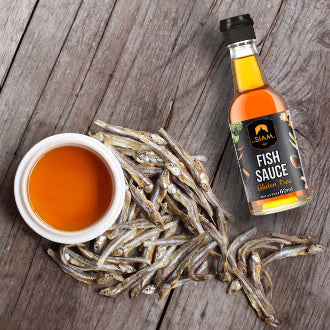
Fish sauce or "Nam Pla"
Fish sauce is an essential condiment and it can even be called the backbone of Thai cooking. The sauce is made from fish coated in salt and fermented for up to two years. Fish sauce is universally used to season most Thai main dishes, from soups, salads, curries, stir-fries, dips to marinades.
Coconut Palm Sugar or "Nam Tan Ma-phrao"
Coconut palm sugar is one of the natural sweeteners Thai people love to use in the food. Made from the sap of the flower bud stem of the coconut palm, it gives a caramelized sweetness with a woodsy, earthy undertone. It is less sweet but more complex in flavor than white cane sugar and offers milder and more flavorsome taste, especially in desserts.
Coconut Milk or “Ka-thi”
Coconut milk is one of the key ingredients of Thai food and widely used in curry dishes and desserts. The coconut milk adds sweetness and body to a dish, creating a pleasant umami flavor.

Thai Curry Pastes
In the past, Thai cooks had to make curry paste by pounding and mixing many herbs and spices together. Thanks to modern technology, Thai chefs can produce tasty curry paste easier and give it a longer shelf life. Now you can find almost every type of Thai curry pastes either green, red, yellow, Massaman or Panang in your local Asian stores. The ready-made Thai curry paste is surely a life and time saving product, especially for beginners.
Tamarind Paste or "Makham Piak"
Tamarind has a delicious sweet and sour tang. When cooking, Thais usually use the fruit in paste or liquid form. The tamarind paste is mainly used in Thai soups, sauces and marinades and some Thai sweets to give a pleasant sour taste.
Kaffir Lime Leaves
The Kaffir Lime leaves are widely used in Thai recipes for curries, salads, and soups, to add a distinct citrus and floral fragrance to the dishes.
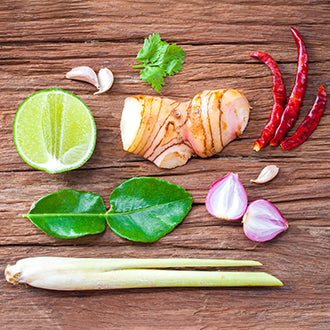
Galangal or “Kha”
Thai people use galangal in various traditional Thai cuisine from curries, soups to salads to add perfume-like scent and flavor to the dishes.
Bird's Eye Chilies or “Phrik Khi Nu”
This small chili is extremely hot and spicy, but it is used extensively in many Thai dishes, such as in Thai curries and in Thai salads, or they can just be eaten raw in a dip or on the side. The chili is popularly used both fresh and dry.
Holy Basil Leaves or “Gra Prow” and Thai Sweet Basil Leaves or “Horapha”
Holy basil or Thai basil has a distinctive scent of spicy, peppery, clove-like taste. It is a staple base of the Thai stir-fry dish ‘Pad Gra Prow’ (minced meat fried with basil) or ‘Pad Khi Mao’ (spicy fried noodles). The holy basil looks similar to sweet basil, but the taste and smell are different. Thais usually use sweet basil leaves in curries such as red and green curry and often serve it separately.
Garlic or “Kra-thiam” and Shallot or “Hom Deang”
Garlics and shallots are extensively used in Thai food, either cooked, fried or eaten raw by mixing in dips or salad dressing.

Rice noodles
Rice noodles are used extensively in Thai cooking, like stir fried noodles dishes, salads and soups. They are quite neutral in flavor and elevate the flavors of ingredients in any dish quite superbly.
Jasmine Rice and Sticky Rice
Most Thai dishes are eaten with steamed rice or steamed sticky rice. Most curry dishes, or Central and Southern cuisine is served with Jasmine rice or steamed rice, while Northern and Isan cuisine is eaten with steamed sticky rice.
When cooking overseas, some ingredients may be difficult to find fresh, you can check “What substitutes to use when you can’t find the right ingredients”.

The Pestle & Mortar
Paste plays a major role in Thai cuisine and Thais use pestle and mortar to blend, mash and fuse flavors and ingredients together. For beginners, it is okay to use a food processor or blender, but pestle and mortar can extract the flavors and essential oils out of them better.
The Wok
Woks are commonly used in Thai cooking because they cook ingredients in a way that a frying pan can’t. The sloped sides make it perfect both as a stir-frying and deep-frying vessel and woks concentrate the heat in the middle and then distribute that heat evenly over the rest of the cooking surface. However, even if it is nice to have a wok to create authentic Thai food buying it may not be easy and it could be pricey. So, using a skillet or a frying pan would be enough for home cooking.
Rice Cooker or Steamer
Thai food is usually paired with rice, either steamed rice or sticky rice so having a rice cooker or steamer is very useful. You can use an electric steamer or rice cooker, or a more traditional method like woven bamboo baskets which give you a pleasant woody scent. You may find it is useful to have a multi-tiered steamer that allows you to steam several dishes at the same time or steam a whole fish or chicken.
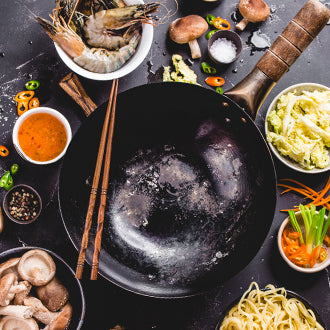
The Chef's Knife and Cutting Board
Thai cooking involves a lot of chopping and slicing, so it is a good idea to invest in good quality knifes like a Chinese-style cleaver and chef’s knife as well as a chopping board to make your Thai cooking easier.
For more details on cooking utensils, you can read “Thai Cooking Utensils You Need!”
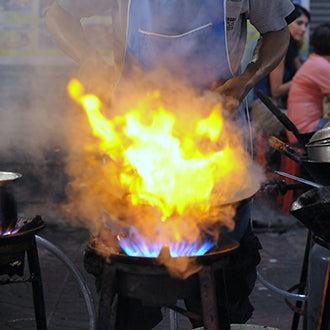
Stir Fry or “Pad”
Stir fry is a cooking technique that is done over high heat and with a small amount of oil, using a wok and a decent sized spatula. After heating oil in the wok, the ingredients are added, tossed and mixed together until all things are cooked (usually taking about 5 minutes to cook).
Steam or “Neung”
Steaming is a moist-heat method of cooking that employs hot steam to conduct the heat to the food. A very clean and healthy approach to cooking as no oil is used.
Stewing or “Toon”
Stewing is a slow cooking method where food is cut into pieces and cooked for longer periods on a lower heat in the water, stock, or sauce. The meat is totally immersed in liquid and slowly simmered.
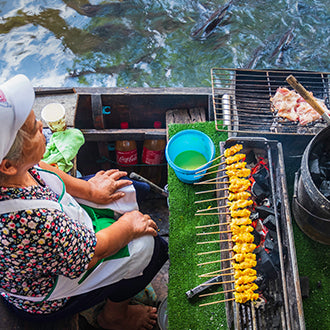
Grilling or “Yang”
Grilling in Thailand is a cooking approach using direct heat and where meats are exposed over the heat source. Sometimes meats are wrapped in banana leaves and placed on a grill that is typically sitting on top of heated coal or charcoal. This grilling technique adds a smokey aroma and flavor to the meat.
Deep Fry or "Tod"
Deep frying is a hot-fat cooking method in which food is submerged in oil that is heated in a pot or deep fryer. Although it can produce some very tasty dishes, it may not be a good choice for those with health concerns or who have weight issues.
Read more about “Thai Cooking Techniques” and “some easy recipes” for beginners to try.